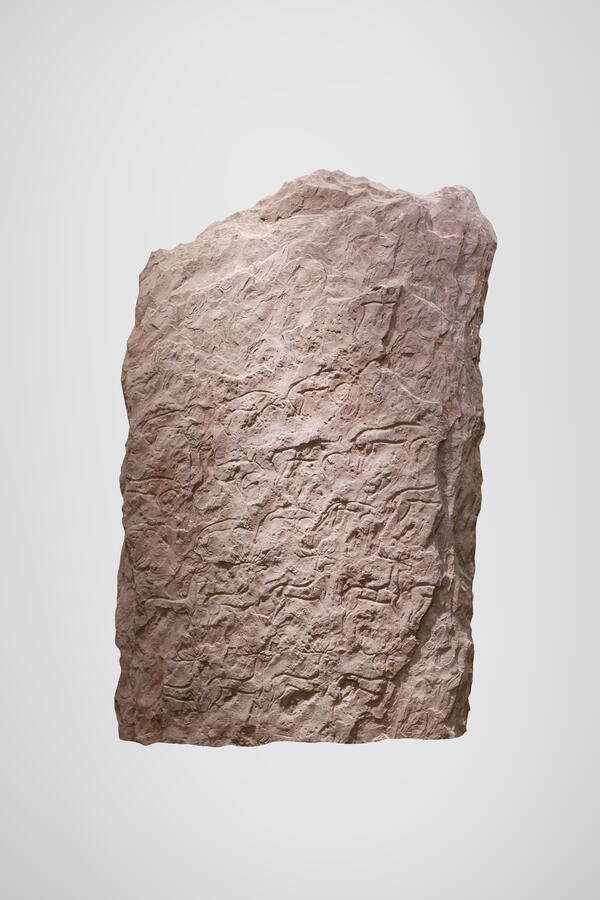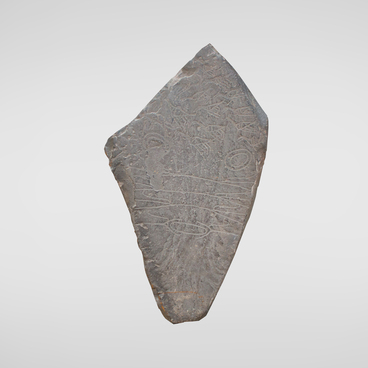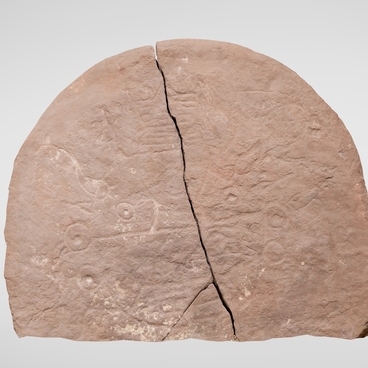Kopyonsky Chaatas is the largest princely burial ground of the Yenisei Kyrgyz of the 7th– 8th centuries in Khakassia. It is located in the Kopyon-Kharagai tract, on the left bank of the Yenisei, near the village of Kopyony. The word “chaatas” in the Khakass language means a “stone of war”. This was the name of the burials of noble warriors.
The stone stela, which was previously installed at the Kopyonskiy Chaatas, is much older than the burial ground itself. It was made in the era of the Okunev archaeological culture — between the end of the 3rd and the beginning of the 2nd millennium BC. In 1739, this statue was discovered by a scientific expedition led by the naturalist Johann Georg Gmelin and the historian Gerhard Friedrich Miller. However, after that, the stela was lost, and it was rediscovered only in the early 1960s. At the same time, archaeologist Leonid Zyablin transported it to the Khakassia National Museum.
The slab is carved from red sandstone: this material was most often used for such sculptures. Its surface is uneven, covered with a bumpy crust, which peels off in places. The edges of the stela are roughly chipped. Images on it are arranged in horizontal rows. They were first carved, and then each line was abraded. There are eight rows in total, but only small fragments have survived from the lower one, from which it is impossible to reconstruct the drawing.
In the first row, three humanoid figures have partially survived. Those who saw the slab in the 1960s testify that these images used to have bird heads. A drawing of the rear of an ungulate animal is seen next to them.
In the second row there are images of bears. An unknown craftsman worked them in such detail that he even carved claws on his paws. The third row is occupied by figures of a moose with branched horns and three moose that follow him. In the fourth row, there are images of four wolves — the first of them has only the front part preserved. The remaining three rows are occupied by drawings of deer.
All the animals on the stela are carved in natural, calm poses. The ancient artist tried to depict them as realistically as possible. Probably, when choosing animals, he relied on the observations of hunters: they noticed that where there are large herbivores, predators always appear.
The stone stela, which was previously installed at the Kopyonskiy Chaatas, is much older than the burial ground itself. It was made in the era of the Okunev archaeological culture — between the end of the 3rd and the beginning of the 2nd millennium BC. In 1739, this statue was discovered by a scientific expedition led by the naturalist Johann Georg Gmelin and the historian Gerhard Friedrich Miller. However, after that, the stela was lost, and it was rediscovered only in the early 1960s. At the same time, archaeologist Leonid Zyablin transported it to the Khakassia National Museum.
The slab is carved from red sandstone: this material was most often used for such sculptures. Its surface is uneven, covered with a bumpy crust, which peels off in places. The edges of the stela are roughly chipped. Images on it are arranged in horizontal rows. They were first carved, and then each line was abraded. There are eight rows in total, but only small fragments have survived from the lower one, from which it is impossible to reconstruct the drawing.
In the first row, three humanoid figures have partially survived. Those who saw the slab in the 1960s testify that these images used to have bird heads. A drawing of the rear of an ungulate animal is seen next to them.
In the second row there are images of bears. An unknown craftsman worked them in such detail that he even carved claws on his paws. The third row is occupied by figures of a moose with branched horns and three moose that follow him. In the fourth row, there are images of four wolves — the first of them has only the front part preserved. The remaining three rows are occupied by drawings of deer.
All the animals on the stela are carved in natural, calm poses. The ancient artist tried to depict them as realistically as possible. Probably, when choosing animals, he relied on the observations of hunters: they noticed that where there are large herbivores, predators always appear.



